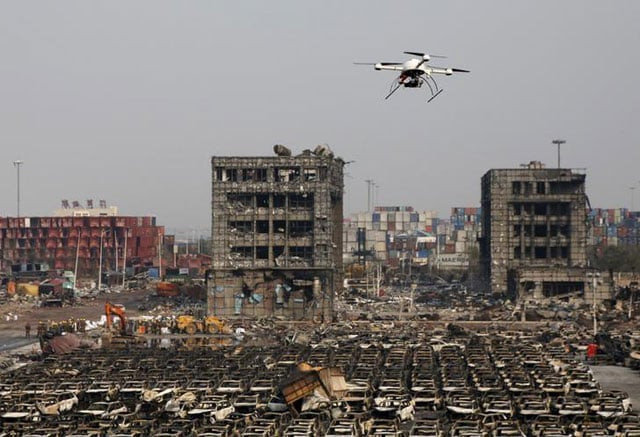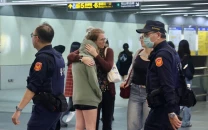Don't count on technology to save you in a disaster
Drones or smartphones could not substitute for the basic infrastructure some countries have lacked for decades, expert

A drone operated by paramilitary police flies over the site of last week's explosions at Binhai new district in Tianjin, China, August 17, 2015. PHOTO: REUTERS
The annual World Risk Report from the United Nations University (UNU) highlights the growing interest in new technologies to improve emergency response - from drones that can survey crisis-hit areas to social media networks that allow survivors to communicate with the wider world.
These can provide important information to the logisticians who organise aid delivery or health workers trying to track deadly diseases like Ebola in no-go areas, the report said.
But Matthias Garschagen, a risk management expert with the UNU Institute for Environment and Human Security (UNU-EHS), said it could not substitute for the basic infrastructure some countries have lacked for decades.
"Too many people see technology as the main panacea for solving all the problems you have after disasters strike," he told the Thomson Reuters Foundation. "A lot of development experts put too much emphasis on technology."
In Africa, for example, there are just 65 kilometres (40 miles) of paved road per 100,000 inhabitants, compared to 832 km in Europe or 552 km in the Americas.
Italy earthquake death toll climbs to 247
In heavy rain, dirt roads soon become impassable, which hampers the delivery of aid, the report said.
"No smartphones in the world are going to significantly change this state of affairs," Garschagen said in the report produced with the University of Stuttgart and Bündnis Entwicklung Hilft, an alliance of German aid agencies.
After the Nepal earthquakes last year, aid agencies used drones to find out the extent of damage, but their uncontrolled flying was a headache for the government, which introduced restrictions.
And in many cases, helicopters were not available to bring in aid to meet the needs identified by aerial surveillance.
Drones themselves cannot be expected to carry out aid deliveries any time soon, because they cannot carry big enough loads and their use is subject to so many rules, said Kathrin Mohr, who heads Deutsche Post DHL Group's "GoHelp" team.
"Some suggest that drones could even carry medicine supplies to remote villages. I think this is complete nonsense," she said in the report.
"Just realise what one of these drones can carry: Not more than one to three kilogrammes. This really is an extremely limited amount."
Humans matter
Garschagen said sound infrastructure - from transport to telecoms and power networks - must be built with disaster risks in mind and properly maintained.
An early warning system, installed in Indonesia after the 2004 Indian Ocean tsunami, malfunctioned in October 2010 when a 3-metre (10 ft) wave crashed into the remote Mentawai islands, taking residents by surprise and killing several hundred people.
"Too often we think infrastructure means building a nice road, a nice bridge or a tsunami early warning system," Garschagen said.
"But we don't pay sufficient attention to the humans and institutions that need to be trained, educated and built around the technology in order to maintain or run it properly."
Google parent Alphabet joins drone tests as US considers new rules
Planners and builders of infrastructure - whether companies, governments or development banks - should also consider the risks from climate change, such as worsening floods, he added.
That is particularly so in Southeast Asia and Africa, where much essential infrastructure is not yet in place, he said.
But pressure from investors in growing cities like Lagos or Ho Chi Minh City can make it difficult to think long term, raising the risk of buildings or transport being located in disaster-prone areas.
An index ranking the risk of disasters for 171 countries, contained in the report, shows the world's hot-spots lie in the Pacific Ocean, Southeast Asia, Central America and Africa's southern Sahel region.



















COMMENTS
Comments are moderated and generally will be posted if they are on-topic and not abusive.
For more information, please see our Comments FAQ